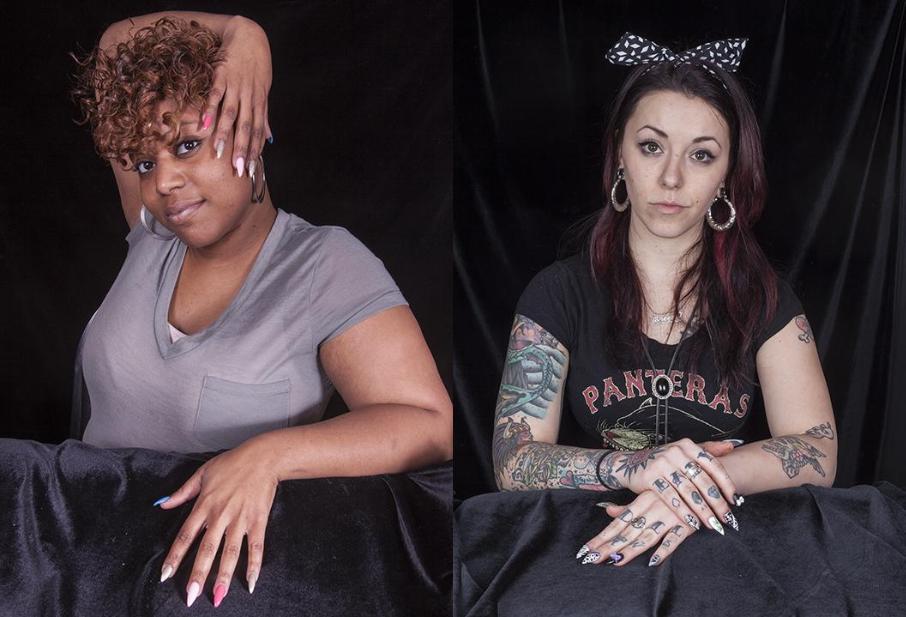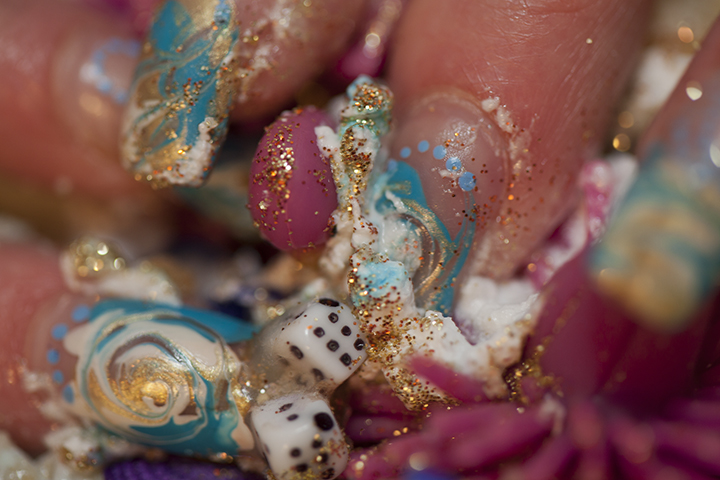Nailed it! The unique history of race and class in Chicago’s nail art
By Britt Julious

Nailed it! The unique history of race and class in Chicago’s nail art
By Britt Julious
Helen Maureen Cooper is next level, existing on a plane that few even know exists, let alone try to reach. Aesthetically-speaking, with her curly red hair, colorful apparel, and long acrylic tips, she stands proud and stands out. Her look is part youthful, all referential, yet decidedly personal. It is a reflection of all that she knows and an indication that what she wants to know still exists, if she is willing to find it.
It is her tips that distinguish Cooper from the women around her both in the art world and in the world at large. Cooper wears acrylics with traditional Chicago artistry. It is this love of nail art – less traditionally accepted forms of nail art, specifically – that serves as the inspiration for her latest solo exhibition, Nailed, opening June 21 at the City Gallery at the Historic Water Tower Place. Nailed includes photographs from her ongoing Hard Candy series featuring close-ups of nails posed on top of and within piles of items such as glitter, frosting, and dice.
The exhibition will also include a new body of work. For her series of large-scale photographs titled Jazzy Nails (named after a now-defunct shop from the 90s), Cooper photographed patrons and nail techs of the Naughty Nail’z shop. Her entrance into the world of nail art was not easy. The acrylic nail art community in general and the Chicago community in particular is not so much exclusive as it is reflective. In Chicago, we see a community that speaks to the diversity of the landscape. The vastness of the city means neighborhoods and sub-neighborhoods, groups and scenes develop before most are even aware they exist.
Throughout her photographic career, Cooper has found inspiration in the physical and the performative.
“Hands are particularly expressive to me,” she said.
Upon moving to Chicago from Philadelphia for graduate school at the School of the Art Institute Chicago, Cooper’s interest in nail art grew. She frequented the now-closed Bottom, a popular shop for women in the know on the West Side of the city. Soon, she realized that the nail art stakes were raised in terms of artistry, commonality and frequency. In Chicago, paint is used in a way that is not global. Nail artists here work with acrylic paints, not nail polish. In their work, we find distinguishing styles – thin and light drags, stripes and lines – that creates a uniform look for the city.
“I can tell who goes to what salon based on what is done,” Cooper said.

In addition to style, Chicago also provided a change in business ownership, diversity of nail artists, and divisions within the scene. Whereas Philadelphia was largely serviced by a Vietnamese community of nail artists, Chicago’s nail artists vary by race in correspondence to the type of designs they create. Black and hispanic women largely work in acrylics.
Local acrylic nail artists are protective of their work and the amount of access they provide to their community. When approached by Cooper, many nail techs expressed their concerns over competition with shops employing Asian women. Cooper herself was an outsider as a white artist. In order to find women to photograph, Cooper began to talk to women on street and on the bus.
Women from a variety of different backgrounds inhabit shops like Naughty Nail’z, but a majority are racial minorities of working or middle class.
“All sorts of women who are not similar go there with weird sorts of racial/cultural tensions with each other, and yet it works,” Cooper said.
“I fell in love with the shop and the type of women that came in,” she said.
Her love of the shop however did not make others agreeable to her artistic pursuits. Her original requests to photograph the space and its inhabitants was denied.

“There were so many possibilities for being skeptical of an outsider,” Cooper said.
In the end, there was no way that she was signifying that she knew what nail language the women were speaking. There is a rightful fear that white artists creating work that showcases or reflects non-mainstream communities are out to exploit these lived experiences. Cooper’s aim as a creator and general fan then was to become a part of the community that she was interested in documenting.
“Until it was something I was doing and that was a part of my life, it would look like cultural tourism,” she said.
Her only true “in” to the space was to get acrylics of her own.
“I just knew that I had to get my own nails done to get to the community,” she said enthusiastically.
Eventually, Cooper was allowed to photograph in the space, first in a documentarian style and later, in portraiture. Allowed to bring in backdrops in January, Coopers photographs became a collaborative performance project exploring how Naughty Nail’z’ customers look and what they are communicating with their look.
“I’m interested in photographing any woman with a sense of presence,” she said. “I’m interested in any woman who is owning who she is.”
The end result is a series of photographs that are loving, positive, and rich with humanity. The women (and children) photographed are not subjects, but her fellow enthusiasts in the community.
Fashion and style are not one in the same. If fashion is the clothes themselves, then style is the expression through those same clothes. In extension, style too is the way one plays with their hair, their accessories of demure or extravagant accoutrement, the way everything is put together to form not a look, but the truest reflection of self.
“I’m interested in how everything that adorns the person expresses something about what their character is,” Cooper said.
A caring glance reveals far more about a person than the first thing they say. Cooper’s own look reflected this ethos. And for the artist, hands reveal the largest truth.
“You learn a lot about a person by seeing what their hands look like,” she said. “Everyone is their own character.”
Britt Julious blogs about culture in and outside of Chicago. Follow Britt’s essays for WBEZ’s Tumblr or on Twitter @britticisms.


